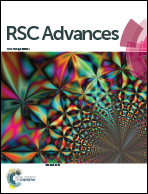Separation of amino acid enantiomers by a capillary modified with a metal–organic framework†
Abstract
A type of homochiral metal–organic framework (MOF), [Zn2(D-Cam)2(4,4′-bpy)]n (D-Cam = D-(+)-camphoric acid; bpy = bipyridyl), was synthesized and utilized as the chiral stationary phase for capillary electrochromatography. X-ray diffraction (XRD), thermogravimetric analysis (TGA) and Fourier-transform infrared spectroscopy (FTIR) were performed to characterize the MOF. The MOF particles were attached to the inner walls of the capillary columns through covalent linkages, and the MOF-modified capillary columns were characterized using scanning electron microscopy (SEM) and energy-dispersive X-ray spectroscopy (EDX). Finally, the enantiomeric separation of phenylalanine and tyrosine was achieved in the MOF-modified capillary columns. The limit of detection (LOD) and the limit of quantitation (LOQ) were 0.1 μg mL−1 and 0.3 μg mL−1, respectively, for the four analytes. The linear range was 0.3–250 μg mL−1 for D-phenylalanine, 0.3–200 μg mL−1 for L-phenylalanine, 0.3–220 μg mL−1 for D-tyrosine and 0.3–180 μg mL−1 for L-tyrosine, all with an R2 > 0.999. The stability of the MOF-modified columns was measured with RSDs. DL-Phenylalanine exhibits intraday, interday and column-to-column precisions of 0.57–12.13%, whereas the data for DL-tyrosine were 0.45–9.93%.


 Please wait while we load your content...
Please wait while we load your content...